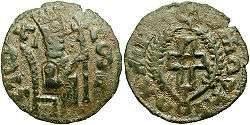Armah
| Armah Kingdom of Aksum | |||
|---|---|---|---|

|
Armah (reigned 614–631), known in some Muslim sources as Al-Najashi (Arabic: النجاشي), was a Christian king of the Kingdom of Aksum. He is primarily known through the coins that were minted during his reign.[1] However, it has been suggested as long ago as 1895 that he was identical to Ashama ibn-Abjar or Sahama, who gave shelter to the Muslim emigrants around 615–6 at Axum.
Scholar of ancient Ethiopia Stuart Munro-Hay (1947–2004) states that either Armah or Gersem were the last Axumite kings to issue coins. Bronze coins from the reign of Armah show him depicted as a full-length figure enthroned, with Christian cross motifs throughout.[2]
Armah's silver coins have an unusual reverse, showing a structure with three crosses, the middle one gilded. Munro-Hay quotes W.R.O. Hahn as suggesting that this is an allusion to the Holy Sepulchre, as a reference to the Persian capture of Jerusalem in 614; if this is correct, it provides a date for Armah.[3]
References
- ↑ A letter to Antoine d'Abbadie, dated 8 January 1869, mentions a coin of this ruler. Rubenson, Sven, ed. (2 September 2000). Acta Aethiopica, Vol. III: Internal Rivalries and Foreign Threats, 1869–1879. Addis Ababa: Addis Ababa University Press. p. 3. ISBN 0-765-80728-9.
- ↑ Markowitz, Mike (22 July 2014). "The Coinage of Aksum". CoinWeek. Retrieved 16 August 2017.
- ↑ Munroe-Hay, Stuart C. (24 June 1991). Aksum: An African Civilization of Late Antiquity. Edinburgh: Edinburgh University Press. p. 91. ISBN 0748601066.
- Atkins, Brian; Juel-Jensen, Bent (1988). "The Gold Coinage of Aksum: Further Analyses of Specific Gravity, A Contribution to Chronology". Numismatic Chronicle (148).